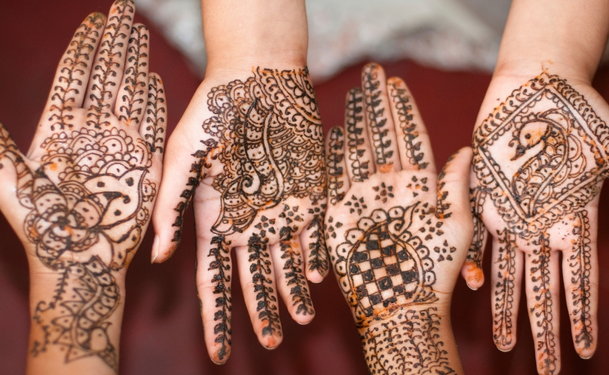Those looking for an alternative to tattooing often turn to henna. Henna body art involves pasting henna onto the skin. The henna paste migrates into the outermost layer of the skin and creates a red-brown stain. Advances in technological preparations in grinding, sifting, temperature control, and packaging have improved dye content and artistic potential for henna. Today, elaborate staining patterns can be done to create temporary tattoos anywhere on the body.
How is henna prepared and applied?
Henna is a flowering plant that is a species of the Lawsonia genus. Whole, unbroken henna leaves cannot stain the skin; henna leaves must be crushed in a mild acid, lemon juice, or strong tea to create a soft paste that can be easily applied to the skin with a toothpick or any dull pointed object.
Once applied, lawsone molecules gradually migrate from the henna paste into the outer layer of the skin. Though henna lawsone can begin to stain the skin within minutes, it should be allowed to remain for four to 12 hours so that the stain can fully take hold. The longer the paste is left on the skin, the more lawsone will migrate.
What happens after henna is applied?
After henna has been applied and allowed to completely dry, the hardened paste will naturally crack and fall off the skin. Any residual powder can be removed by washing the skin with water. Initially the dye is bright orange but will start to darken within 2-3 days.
Henna tattoos appear darkest on the thickest layers of the skin, like the hands, feet and thighs. Steaming or warming the henna pattern will darken the stain, either during the time the paste is still on the skin or after the paste has been removed.
How long do henna tattoos usually last?
The dye starts to fade after 3-4 weeks, though stains from henna can last anywhere from a few weeks to a few months. Chlorinated water and soaps may slow the darkening process, while alkaline may hasten the darkening process. Once henna dye has reached its maximum intensity, it will appear to fade. The henna stain actually does not fade; skin cells shed off and are replaced by new unstained cells.
Are there any side effects associated with henna?
Allergic reactions to natural henna are rare. The few individuals who do experience side effects may complain of itching or blistering at the site where the henna was applied. Unlike other agents, henna is rarely associated with anaphylactic allergic reactions. To ensure no serious side effects occur, henna should never be injected or taken orally.
How much do henna tattoos cost?
Henna tattoos can be done at home or by a professional. The paste itself is only a few dollars. However, intricate and complex designs are usually performed by a professional henna artist who may charge anywhere between $20-$40. Most artists spend about 1-2 hours designing henna tattoos.


